Dill
Anethum graveolens
These lacy, feathery, bright green leaves are topped by an umbrella-shaped constellation of seeds. Useful as an herb, the leaves are traditional in many Eastern European culinary traditions and the seeds and stems are classic additions to pickles. Dill has a long history of use as a medicinal herb in several traditions to soothe digestion. Be prepared to share your dill plants with the caterpillars of black swallowtail butterflies. It's easy to grow enough to share! Scatter on cool soil in early spring or in the cooling days of late summer. Just barely cover seeds and keep evenly moist until germination.
Second photo comes from H. Zell, CC BY-SA 3.0, via Wikimedia Commons.
Days to maturity: 40-45 to leaf harvest; 85-105 to seed
Seeds per pack: 200
Germination rate: 57% on 12/23/2024 (below standard)
Planting / harvesting notes
Scatter on cool soil in early spring or in the cooling days of late summer. Just barely cover seeds and keep evenly moist until germination. If you'd like to be more exact: sow seeds directly in the soil in early spring 2-3 seeds per inch about ¼" deep. Thinning is not necessary. If starting seeds indoors, begin 6-8 weeks before last frost and then transplant 6" apart.
Seed keeping notes
Allow the spent flowers to ripen into plump green seeds, and then dry on the plant until the seeds have turned papery. Harvest umbel by umbel, or take the entire flower stalk as all attached seeds are dry. Allow seed heads to dry out further in a protected place with good ventilation and low humidity. Thwack the seed heads inside a bucket, or pull them off. Remove chaff and allow seeds to dry further on a paper bag or towel. Store in a screw-top jar.







